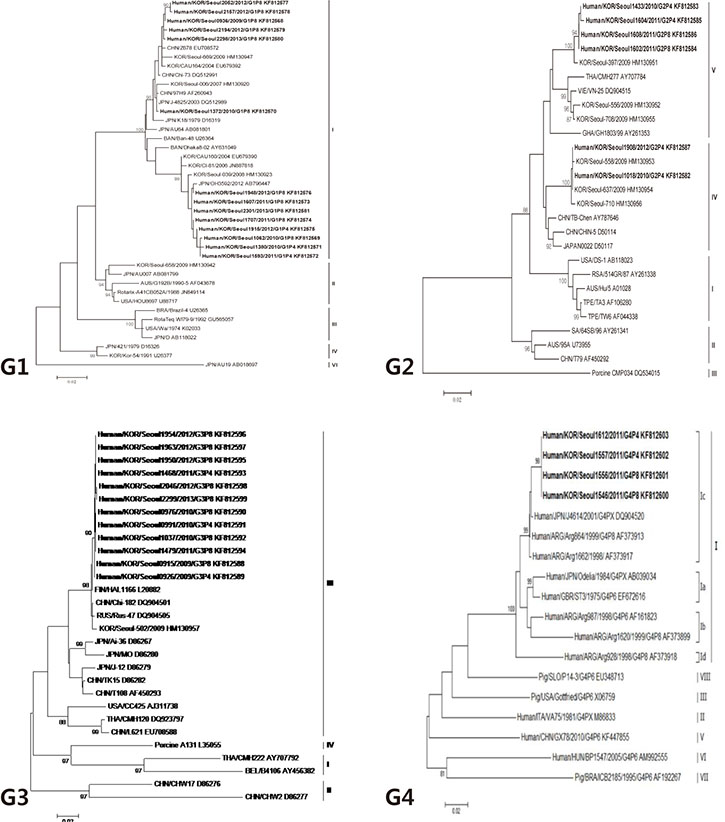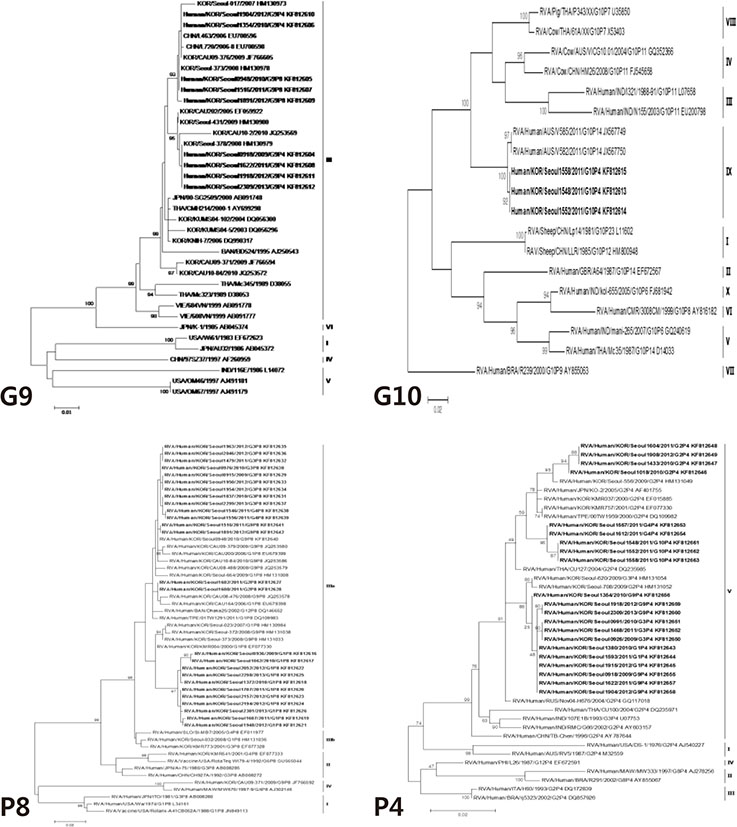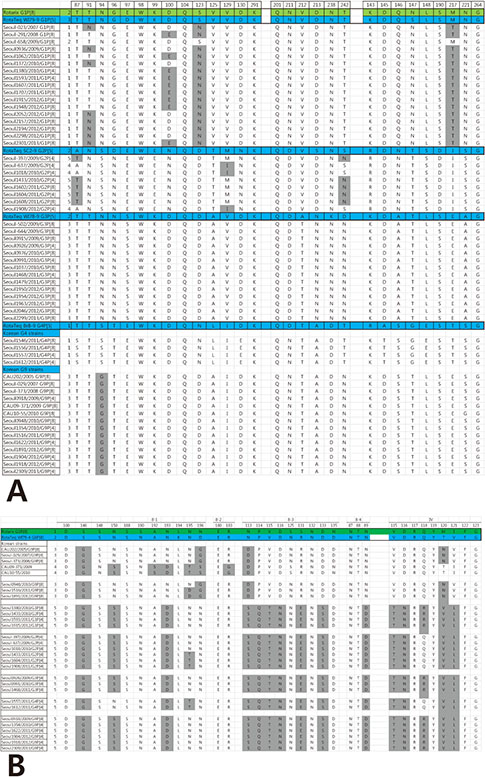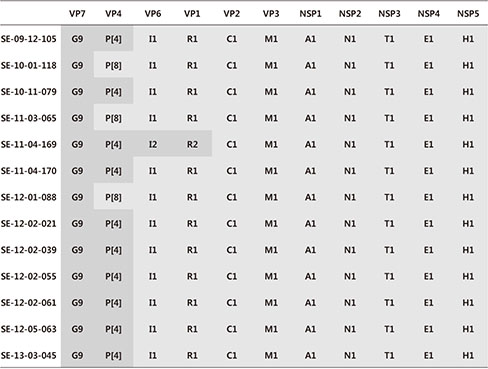Pediatr Infect Vaccine.
2015 Aug;22(2):81-90. 10.14776/piv.2015.22.2.81.
Distribution of Human Rotavirus Genotypes in a Tertiary Hospital, Seoul, Korea During 2009-2013
- Affiliations
-
- 1Department of Diagnostic Laboratory Medicine, Sanggyepaik Hospital, Inje University College of Medicine, Seoul, Korea.
- 2Seoul Health Environmental Center, Virus Team, Seoul, Korea.
- 3Department of Pediatrics, Sanggyepaik Hospital, Inje University College of Medicine, Seoul, Korea. chungjy@paik.ac.kr
- 4Department of Microbiology and Immunology, Seoul National University School of Medicine, Seoul, Korea.
- KMID: 2465252
- DOI: http://doi.org/10.14776/piv.2015.22.2.81
Abstract
- PURPOSE
Group A rotavirus (RV) is most common etiologic agent of acute gastroenteritis (AGE) in children worldwide. Recently, vaccination has been introduced in several countries to reduce the disease burden caused by RV infections, but continuous surveillance of RV strains is necessary to detect the emergence of potential variants induced by vaccine-immune pressure. This study aimed to investigate the changing pattern of RV genotypes in children with AGE, following the introduction of vaccination in Korea.
METHODS
Genotyping of RVs by RT-PCR on the basis of VP7 and VP4 gene segment sequence was carried out on 201 rotavirus-positive stool samples, from children hospitalized with AGE between August 2009 and June 2013. We have directly sequenced PCR products and analyzed the phylogenetic tree.
RESULTS
The most prevalent G genotype was G9 (33.3%), followed by G1 (22.4%), G3 (15.9%), G2 (6.0%), G4 (3.0%), G10 (1.5%), and mixed G-type (15.4%), with some nontypeable cases (2.5%). The detected P genotypes were P[4] (45.3%), P[8] (43.8%), mixed P-type (10.4%), and P[2] (0.5%). The G9P[4] genotype was predominantly observed in hospitalized cases in Seoul in 2010/2011, however G1P[8] has been re-emerged as the predominant genotype in the following season (P=0.004).
CONCLUSIONS
It seems that the periodic fluctuation in predominance of the G1, G3, and G9 strains occurred in Korea during 2009-2013, following the introduction of RV vaccination.
Keyword
MeSH Terms
Figure
Reference
-
1. Matthijnssens J, Ciarlet M, McDonald SM, Attoui H, Banyai K, Brister K, et al. Uniformity of rotavirus strain nomenclature proposed by the Rotavirus Classification Working Group (RCWG). Arch Virol. 2011; 156:1397–1413.
Article2. Matthijnssens J, Van Ranst M. Genotype constellation and evolution of group A rotaviruses infecting humans. Curr Opin Virol. 2012; 2:426–433.
Article3. Banyai K, Laszlo B, Duque J, Steele AD, Nelson EA, Gentsch JR, et al. Systemic review of regional and temporal trends in global rotavirus strain diversity in the pre rotavirus vaccine era: insights for understanding the impact of rotavirus vaccine programs. Vaccine. 2012; 30:A122–A130.4. Than VT, Jeong S, Kim W. A systemic review of genetic diversity of human rotavirus circulating in South Korea. Infect Genet Evol. 2014; 28:462–491.5. Han TH, Kim CH, Chung JY, Park SH, Hwang ES. Genetic characterization of rotavirus in children in South Korea from 2007 to 2009. Arch Virol. 2010; 155:1663–1673.
Article6. Carvalho-Costa FA, Araujo IT, de Assis RMS, Fialho AM, Martins CM, Boja MN, et al. Rotavirus genotype distribution after vaccine introduction, Rio de Janeiro, Brazil. Emerg Infect Dis. 2009; 15:95–97.
Article7. Gurgel RQ, Cuevas LE, Vieira SC, Barros VC, Fontes PB, Salustino EF, et al. Predominance of rotavirus P[4]G2 in a vaccinated population, Brazil. Emerg Infect Dis. 2007; 13:1571–1573.
Article8. Kirkwood CD, Boniface K, Barnes GL, Bishop RF. Distribution of rotavirus genotypes after introduction of rotavirus vaccines, Rotarix® and RotaTeq®, into the National Immunization Program of Australia. Pediatr Infect Dis J. 2011; 30:S48–S53.
Article9. Choe YJ, Yang JJ, Park SK, Choi EH, Lee HJ. Comparative estimation of coverage between national immunization program vaccines and non-NIP vaccines in Korea. J Korean Med Sci. 2013; 28:1283–1288.
Article10. Lee SG, Jeon SY, Kim KY. 2012 Korea National Immunization Survey [internet]. Korean CDC;cited 2014 Aug 4. Available from http://www.cdc.go.kr/CDC/info/CdcKrInfo0201.jsp?menuIds=HOME001-MNU1155-MNU1083-MNU1375-MNU0025&cid=20768.11. Banerjee I, Ramani S, Primrose B, Iturriza-Gomara M, Gray JJ, Brown DW, et al. Modification of rotavirus multiplex RT-PCR for the detection of G12 strains based on characterization of emerging G12 rotavirus strains from South India. J Med Virol. 2007; 79:1413–1421.
Article12. Gouvea V, Glass RI, Woods P, Taniguchi K, Clark HF, Forrester B, et al. Polymerase chain reaction amplification and typing of rotavirus nucleic acid from stool specimens. J Clin Microbiol. 1990; 28:276–282.
Article13. Gentsch JR, Glass RI, Woods P, Gouvea V, Flores J, Das BK, et al. Identification of group A rotavirus gene 4 types by polymerase chain reaction. J Clin Microbiol. 1992; 30:1365–1373.
Article14. Iturriza-Gomara M, Kang G, Gray J. Rotavirus genotyping: keeping up with an evolving population of human rotaviruses. J Clin Virol. 2004; 31:259–265.
Article15. Tamura K, Dudley J, Nei M, Kumar S. MEGA 4: Molecular evolutionary genetics analysis (MEGA) software version 4.0. Mol Biol Evol. 2007; 24:1596–1599.
Article16. Choi UY, Lee SY, Ma SH, Jang YT, Kim JY, Kim HM, et al. Epidemiological changes in rotavirus gastroenteritis in children under 5 years of age after the introduction of RV vaccines in Korea. Eur J Pediatr. 2013; 172:947–952.
Article17. da Silva MF, Gómez MM, Rose TL, Volotão Ede M, Carvalho-Costa FA, Bello G, et al. VP8*P[8] lineages of group A rotaviruses circulating over 20 years in Brazil: proposal of six different sub-lineages for P[8]-3 clade. Infect Genet Evol. 2013; 16:200–205.
Article18. Linhares AC, Stupka JA, Ciapponi A, Bardach AE, Glujovsky D, Aruj PK, et al. Burden and typing of rotavirus group A in Latin America and the Caribbean: systematic review and meta-analysis. Rev Med Virol. 2011; 21:89–109.
Article19. Martinez M, Amarilla AA, Galeano ME, Aquino VH, Farina N, Russomando G, et al. Predominance of rotavirus G2P[4] and emergence of G12P[9] strains in Asuncion, Paraguay, 2006–2007. Arch Virol. 2010; 155:525–533.
Article20. Huh JW, Kim WH, Yoon MH, Lim YH. Genotypic distribution of rotavirus strains causing severe gastroenteritis in Gyeonggi province, South Korea, from 2003 to 2005. Arch Virol. 2009; 154:167–170.
Article21. Jeong HS, Lee KB, Jeong AY, Jo MY, Jung SY, Ahn JH, et al. Genotypes of the circulating rotavirus strains in the seven prevaccine seasons from September 2000 to August 2007 in South Korea. Clin Microbiol Infect. 2011; 17:232–235.
Article22. Kang JO, Kilgore P, Kim JS, Nyambat B, Kim J, Suh HS, et al. Molecular epidemiological profile of rotavirus in South Korea, July 2002 through June 2003; emergence of G4P[6] and G9P [8] strains. J Infect Dis. 2005; 192:S57–S63.23. Kim JS, Kang JO, Cho SC, Jang YT, Min SA, Park TH, et al. Epidemiological profile of rotavirus infection in the Republic of Korea results from prospective surveillance in the Jeongeub District, 1 July 2002 through 30 June 2004. J Infect Dis. 2005; 195:S49–S56.
Article24. Shim JO, Thai Than V, Ryoo E, Lim I, Yoon Y, Kim K, et al. Distribution of rotavirus G and P genotypes approximately two years following the introduction of rotavirus vaccines in South Korea. J Med Virol. 2013; 85:1307–1312.
Article25. Hull JJ, Teel EN, Kerin TK, Freeman MM, Esona MD, Gentsch JR, National Rotavirus, et al. United States rotavirus strain surveillance from 2005 to 2008: genotype prevalence before and after vaccine introduction. Pediatr Infect Dis J. 2011; 30:S42–S47.26. Bok K, Matson DO, Gomez JA. Genetic variation of capsid protein VP7 in genotype g4 human rotavirus strains: simultaneous emergence and spread of different lineages in Argentina. J Clin Microbiol. 2002; 40:2016–2022.
Article27. Bucardo F, Karlsson B, Nordgren J, Paniaqua M, Gonzalez A, Amador JJ, et al. Mutated G4P[8] rotavirus associated with a nationwide outbreak of gastroenteritis in Nicargua in 2005. J Clin Microbiol. 2007; 45:990–997.
Article28. Matthijnssens J, Helen E, Zeller M, Rahman M, Lemey P, Van Ranst M. Phylodynamic analyses of rotavirus genotypes G9 and G12 underscore their potential for swift global spread. Mol Biol Evol. 2010; 27:2431–2436.
Article29. Esona MD, Banyai K, Foytich K, Freeman M, Mijatovic-Rustempasic S, Hull J, et al. Genomic characterization of human rotavirus G10 strains from the African Rotavirus Network: relationship to animal rotaviruses. Infect Genet Evol. 2011; 11:237–241.
Article30. Chitambar SD, Ranshing SS, Pradhan GN, Kalrao VR, Dhongde RK, Bavdekar AR. Changing trends in circulating rotavirus strains in Pune, western India in 2009-2012: Emergence of a rare G9P[4] rotavirus strain. Vaccine. 2014; 32:A29–A32.
Article31. Tatte VS, Chothe NS, Chitambar SD. Characterisation of rotavirus strains identified in adolescents and adults with acute gastroenteritis highlights circulation of non-typeable strains: 2008-2012. Vaccine. 2014; 32:Suppl 1. A68–A74.
Article32. Afrad MH, Rahman MZ, Matthijnssens , Das SK, Faruque AS, Azim T, et al. High incidence of reassortant G9P[4] rotavirus strain in Bangladesh: Fully heterotypic from vaccine strains. J Clin Virol. 2013; 58:755–756.
Article33. Yen C, Figueroa JR, Uribe ES, Carmen-Hernandez LD, Tate JE, Parashar UD, et al. Monovalent rotavirus vaccine provides protection against an emerging fully heterotypic G9P[4] rotavirus strain in Mexico. J Infect Dis. 2011; 204:783–786.
Article34. Afrad MH, Hassan Z, Farjana S, Moni S, Barua S, Das SK, et al. Changing profile of rotavirus genotypes in Bangladesh, 2006-2012. BMC Infect Dis. 2013; 13:e320.
Article35. Hemming M, Vesikari T. Genetic diversity of G1P[8] rotavirus VP7 and VP8 antigens in Finland over a 20-year period: no evidence for selection pressure by universal mass vaccination with RotaTeq® vaccine. Infect Genet Evol. 2013; 19:51–58.
Article
- Full Text Links
- Actions
-
Cited
- CITED
-
- Close
- Share
- Similar articles
-
- High Prevalence of Rotavirus G4P[6] Genotypes among Neonates in Two Korean Hospitals
- Prevalence of rotavirus genotypes in South Korea in 1989-2009: implications for a nationwide rotavirus vaccine program
- VP7 Genotypes of Group A Rotavirus Isolated from Infants and Toddlers with Rotavirus Gastroenteritis in Jeju
- Molecular Characterization of Norovirus and Rotavirus in Outbreak of Acute Gastroenteritis in Seoul
- Rotavirus Vaccines






